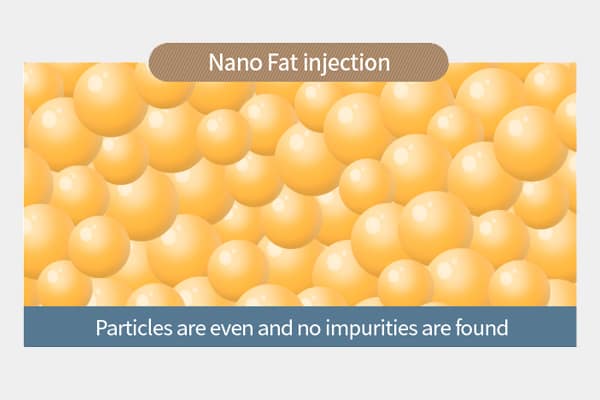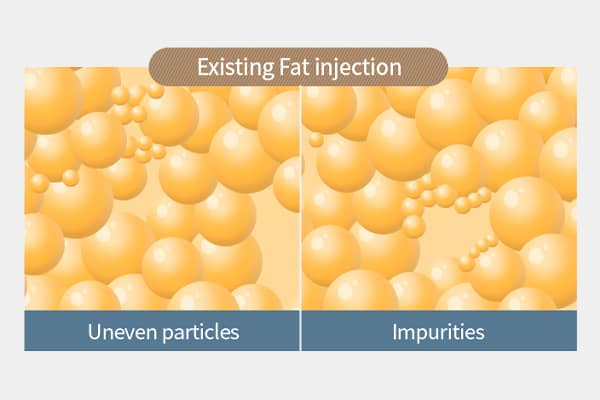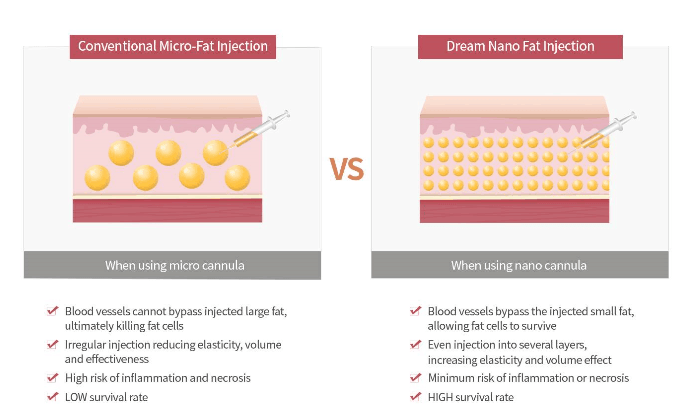
DREAM
Nano Facial Fat Grafting

Procedure Time
1 – 1.5 Hours

Anaesthesia
Light Sedation

Recovery Period
10 – 14 Days

Stitch Removal
7 Days Post-op
What Is Nano Facial Fat Grafting Or Fat Injection?
Nano facial fat grafting which is also commonly referred to as fat injection is a surgical procedure that extracts unnecessary fat from different areas of the body like abdomen, buttocks, and thighs to graft it into the face in appropriate areas. The procedure uses a thin cannula for fat extraction so that only pure fat could be extracted and transferred where needed.
The procedure can improve patient’s overall face dimension while amplifying anti-aging benefits to make their face look more youthful.


Read More: What is Face Fat Grafting in Singapore?
Why Nano Facial Fat Injection?
This facial fat grafting technique selectively transfers pure fat having uncontaminated and healthy living cells collected after double filtration. The cannula used in this procedure is also much thinner compared to the conventional cannulas. It makes sure that when the surgeon reinjects the fat throughout the area that has been treated, fat cells are distributed evenly throughout to prevent any unevenness. As a result, the patient gets smoother skin with minimal uneven patches on the surface of the skin.
Advantages Of Nano Facial Fat Injection Technique
Injection Technique To Get Smooth, Even Results
With traditional fat grafting techniques, the treated area can appear bumpy because too much of grafting is done on a single layer. In the case of Nano Facial Fat Grafting, however, a small amount of fat is grafted evenly on each layer.

Who Needs Nano Fat Injection?
Fat injection is recommended for patients who:
- Have uneven or sunken forehead
- Want to have improved smile lines
- Have sunken eyelids
- Wish to get rid of wrinkles and lines to get a more youthful look
- Want to soften their flat bony forehead
- Want to soften their flat bony cheeks
- Want to even out skin dimpling on their chin
- Wish to have an improved low nose bridge
- Want to have a younger look without going for filler and anti-wrinkle injections
Facial Areas Suitable For Fat Grafting

Fat Grafting Surgery Method

Step 1
The surgeon will start the procedure by extracting fat from the thighs, abdomen, buttocks, breast or any other donor areas.

Step 2
Pure fat is then separated, purified and used for fat injection

Step 3
A tiny cannula is then used for injecting the required fat amounts into subcutaneous skin, facial plane or muscles of the desired area, all along the invisible creases. Finally, the injected areas are stitched if necessary.
Frequently Asked Questions (FAQ) about Facial Fat Grafting in Singapore
Which Parts Of The Face Respond The Best To Fat Injection?
Most areas of your face and body will react well to fat grafting, except for the lips and laugh lines. Although lips and laugh lines are treatable, those areas may require at least 2- 3 fat-grafting sessions before results become prominent.
Do I Need A Lot Of Fat For Facial Fat Injection? Does Taking Fat Leave A Dent?
The quantity of fat required for transfer is relatively small and most skinny patients can qualify for the procedure too. Since the fat required for facial grafting is very little, removing fat from a donor site will not cause any dents in the skin.
For instance, regular liposuction of the love handles can involve removal of around 500 CC of fat, the 50 to 80 CC of fat collected for grafting is practically inconsequential with regards to having an obvious effect at the donor site.
What Is The Recovery For Facial Fat Injection?
Although there is no requirement of any big incisions or bandages in facial fat grafting, recovery time is still necessary. Swelling and puffiness will appear on the very first week of the procedure. In the second week, you will have a less swollen face and look more natural than the previous week. Most of the bruising would have subsided by the second week.
Most people can return to work after 7 to 10 days following their procedure. They can choose to wear dark sunglasses which will help you to easily hide the swelling around the eyes. Patients can also choose to apply makeup if they prefer to conceal the remnant bruising.
Are There Any Precautions That I Need To Follow After Fat Injection?
The plastic surgeon will advise on the list of things you should do or avoid after your procedure, as well as tips and instructions on post-surgery care.
In general, it is a smart idea to reduce your salt intake for a week to help reduce swelling following a fat grafting surgery. Additionally, you should refrain from engaging in hectic household work or any heavy lifting, which can result in more swelling.
Occasional icing of the fat grafted areas will help decrease swelling, relieve pain and discomfort more quickly. You will not need to clean or deal with any cut lines as this procedure involves no incisions.
What Will I Feel Like After Fat Grafting?
The facial fat grafting will leave you with a more youthful and fresh-looking face. The fat harvesting areas will feel a bit sore and tender, as though you have worked them out the day before. You may also experience flushing and tightness of the face for a few days after the procedure. However, these minor discomforts should last just a few days.
Are There Any Changes To My Skin After Fat Grafting?
Fat grafting is known to make your skin much softer and smoother after the procedure. Some patients may also enjoy reduction in the fine lines and wrinkles around the eyes, cheeks, and jawline as the facial areas are volumized.
Fat grafting rejuvenates the skin in an impressive manner. Stem cells which can be found in the graft fat helps with skin rejuvenation and improves the tone and texture as well as reverse other signs of aging.
When Will I Be Able To See The Results?
You may experience mild swelling of the face and it may appear as though you were over-filled. Surgeons infuse additional fatty tissue because some graft will reduce and shrink in the new area. The swelling will subside gradually in three to four months – leaving you with a fresh-looking, rejuvenated face.
Can Fatty Tissue Be Frozen Or Stored?
Studies have proven that storing or freezing your fat kills fat cells. Therefore, liposuction and fat grafting is done on the same day for optimal results.
When Will I Be Able To Exercise After Fat Grafting?
Most surgeons recommend getting back to light physical activity at about 10 to 14 days. In any case, surgeons don’t want their patients indulging themselves in activities that could interfere with the outcomes of the fat grafts. The patient can resume their usual physical activities after 4 weeks following the procedure.
Will I Look Fatter After Fat Grafting?
This is one of the most common concerns expressed by the patients before the surgery. However, it’s just a myth and you will not experience a bulky look following fat grafting. The plastic surgeon just places fatty tissue along hollow areas of the face, e.g., around the eyes, the anterior chin, and cheeks.
Placing fat on the neck and jowls would make you look fatter, which is not a standard procedure done by plastic surgeons. Additionally, if you have a slightly heavier jowls or neck, grafting fat into the hollow facial areas can rebalance your facial proportion and result in a slimmer look.
What If I Gain Or Lose Weight?
With age, most people tend to put on some weight, which is quite natural and normal. The slight difference will not make any huge impact to your facial grafts. However, major weight fluctuations will affect the results from past fat grafting procedures.
What Factors Determine Fat Survivability?
Fat cells are vulnerable to death from the process of harvesting to injection. For the survival of fat cells, it’s important that they must be collected and injected in the right way. The pressure generated to graft fat cells must be great enough to aspirate the fat, but it should not damage the integrity of the cells. Therefore, technique of the procedure is an important component of successful fat grafting.
After the collecting the fat, it is important to inject it as soon as it is processed and ready for grafting. If collection of fat is done in the beginning of a procedure and injected into the targeted area many hours after the liposuction, there are chances of cell death – depending on the time interval between the two steps. Cooling fat at room temperature is very advantageous for cell viability.
The injection technique matters as well. The location of the donor fat, size of the injection cannula and syringe, and the time interval between harvest and inject, all play roles in fat survivability. In case of a small canula, the injury from fat infusion through a little opening can harm cells. On the other hand, if the cannula being used too large, a lot of fat might be infused into any one area – that can cause “fat cell crowding.” This type of packed infusion will result in cell death as each fat cell needs its own blood supply to survive and grow.
A variety of factors play a role in survivability and hence it is difficult to give straight percentages about sustainability of the fat. Donor site is the last factor one should consider when it comes to fat grafting. Areas with abundant fat cell percentage (buttocks, breast, cheeks) will have a higher fat cell survival than areas that lack local fat deposition (lips, temples, etc). Frequent over-correction is needed in areas that have practically zero local fat.
How Much Is Facial Fat Injection In Singapore?
Depending on the number of areas as well as the procedure duration, cost involved varies. As each patient’s expectation differs, a pre-assessment will be required before we can advise the final fees.
